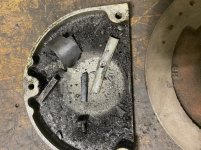G-ManBart
Cast Iron
- Joined
- Aug 17, 2016
I recently bought what seems to be a fairly clean 2J2 that comes back as a 1985 model. I ordered a VFD for it and temporarily wired it up to just be able to see if it worked before going any further (I still have to move the machine to its final spot, etc.
I was able to get the mill to start, but after just a couple of seconds (like 2 or 3) the motor makes an odd scraping noise, the VFD throws a code and I can stop the motor with my finger. I pulled the motor and tried it with no load...same thing. It turns freely, seems smooth and I can't feel any movement when I push/pull on the shaft, so I'm guessing it's either on the other end of the shaft, or something else....I know very little about electric motors. If anybody has any thoughts I'd appreciate them. Ultimately, I'll probably be looking for a shop in the Detroit area to take a look at it.
When I dropped the pulley cover I found some parts in it...half of the key, the set screw, some of a plastic bushings and the plastic slider the key rides on. As you can imagine, the veridisc and spring assembly were wobbling a bit on the shaft. I did some research and it sounded like some folks simply replace the disc and spring assembly rather than repairing it. Does that make any sense? I have a press and should be able to get the spring off safely, and the replacement parts look affordable. Is this a balance issue if people replace the assembly or am I missing something?
There was definitely some black grit inside the case and in the cover, but the belt looked fine. I'm guessing it's probably smarter to just replace the belt since the motor is out, right?
So, any advice or thoughts on the above would be appreciated. If there's anything else I should have addressed don't feel bad about pointing it out...I'm certainly inexperienced with machinery and trying to learn as I go. Thanks!


I was able to get the mill to start, but after just a couple of seconds (like 2 or 3) the motor makes an odd scraping noise, the VFD throws a code and I can stop the motor with my finger. I pulled the motor and tried it with no load...same thing. It turns freely, seems smooth and I can't feel any movement when I push/pull on the shaft, so I'm guessing it's either on the other end of the shaft, or something else....I know very little about electric motors. If anybody has any thoughts I'd appreciate them. Ultimately, I'll probably be looking for a shop in the Detroit area to take a look at it.
When I dropped the pulley cover I found some parts in it...half of the key, the set screw, some of a plastic bushings and the plastic slider the key rides on. As you can imagine, the veridisc and spring assembly were wobbling a bit on the shaft. I did some research and it sounded like some folks simply replace the disc and spring assembly rather than repairing it. Does that make any sense? I have a press and should be able to get the spring off safely, and the replacement parts look affordable. Is this a balance issue if people replace the assembly or am I missing something?
There was definitely some black grit inside the case and in the cover, but the belt looked fine. I'm guessing it's probably smarter to just replace the belt since the motor is out, right?
So, any advice or thoughts on the above would be appreciated. If there's anything else I should have addressed don't feel bad about pointing it out...I'm certainly inexperienced with machinery and trying to learn as I go. Thanks!







